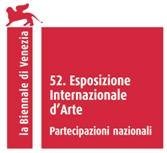Create an account
Welcome! Register for an account
La password verrà inviata via email.
Recupero della password
Recupera la tua password
La password verrà inviata via email.
-
- container colonna1
- Categorie
- #iorestoacasa
- Agenda
- Archeologia
- Architettura
- Arte antica
- Arte contemporanea
- Arte moderna
- Arti performative
- Attualità
- Bandi e concorsi
- Beni culturali
- Cinema
- Contest
- Danza
- Design
- Diritto
- Eventi
- Fiere e manifestazioni
- Film e serie tv
- Formazione
- Fotografia
- Libri ed editoria
- Mercato
- MIC Ministero della Cultura
- Moda
- Musei
- Musica
- Opening
- Personaggi
- Politica e opinioni
- Street Art
- Teatro
- Viaggi
- Categorie
- container colonna2
- container colonna1
52 Biennale. Padiglione giapponese
“Is There a Future for Our Past? The Dark Face of the Light” il titolo della personale di Masao Okabe
Comunicato stampa
Segnala l'evento
The Japan Foundation, the organizer of the Japanese Pavilion at the Venice Biennale of Art, has announced the commissioner for Japan and the artist to represent Japan at the fifty-second biennale to be held from June 10 to November 21, 2007 under the direction of Robert Storr, Dean, Yale University School of Art.
Masao Okabe is the artist who will represent Japan. Okabe has been depicting towns and architecture by frottage, a technique of capturing material images by laying sheets of paper on the material and then rubbing over it with a soft pencil. His works are often described as “rubbing of history,” and his exhibition at the Venice Biennale will be made into a temporary historical space by displaying his 1,400 frottages from the port of Ujina, Hiroshima City, and a 16-meter row of A-bombed stones of the Ujina station platform in Hiroshima. Okabe will also conduct a workshop with Venetian citizens to make frottages of Venetian historical buildings and structures. He has been carrying on similar workshops for years in diverse cities, including Amsterdam, Barcelona, Gwangju, Hiroshima, Nemuro, and Paris. Exchanges of frottage aerograms between Venice and other cities are expected to take place during the biennale.
Okabe, born in 1942 in Hokkaido, began frottage in 1977. He has exhibited at the third Gwangju Biennale (2000) and the Echigo-Tsumari Art Triennial (2000) and has held frottage workshops under the Synchronicity Project (2004) and the Masao Okabe+City 2005 Project (2005) in Japan.
Chihiro Minato, the commissioner for Japan, describes the exhibition concept in the following words: “The subject of the frottages is the port of Ujina. The Ujina train station was a hub through which tremendous volumes of cargo and people were transported to Asia from the time of the Sino-Japanese War until World War II, as well as an area affected by the atomic bomb. Okabe spent nine years making frottages of the platform stones. The station no longer exists, as it was taken down for the construction of an expressway, but Okabe has recorded the past by using the elemental tools of pencil and paper. With this lifework of Okabe as the centerpiece, the exhibition will attempt to consider, from the perspective of art, the possibilities and conditions for the human past being inherited into the future.”
Masao Okabe is the artist who will represent Japan. Okabe has been depicting towns and architecture by frottage, a technique of capturing material images by laying sheets of paper on the material and then rubbing over it with a soft pencil. His works are often described as “rubbing of history,” and his exhibition at the Venice Biennale will be made into a temporary historical space by displaying his 1,400 frottages from the port of Ujina, Hiroshima City, and a 16-meter row of A-bombed stones of the Ujina station platform in Hiroshima. Okabe will also conduct a workshop with Venetian citizens to make frottages of Venetian historical buildings and structures. He has been carrying on similar workshops for years in diverse cities, including Amsterdam, Barcelona, Gwangju, Hiroshima, Nemuro, and Paris. Exchanges of frottage aerograms between Venice and other cities are expected to take place during the biennale.
Okabe, born in 1942 in Hokkaido, began frottage in 1977. He has exhibited at the third Gwangju Biennale (2000) and the Echigo-Tsumari Art Triennial (2000) and has held frottage workshops under the Synchronicity Project (2004) and the Masao Okabe+City 2005 Project (2005) in Japan.
Chihiro Minato, the commissioner for Japan, describes the exhibition concept in the following words: “The subject of the frottages is the port of Ujina. The Ujina train station was a hub through which tremendous volumes of cargo and people were transported to Asia from the time of the Sino-Japanese War until World War II, as well as an area affected by the atomic bomb. Okabe spent nine years making frottages of the platform stones. The station no longer exists, as it was taken down for the construction of an expressway, but Okabe has recorded the past by using the elemental tools of pencil and paper. With this lifework of Okabe as the centerpiece, the exhibition will attempt to consider, from the perspective of art, the possibilities and conditions for the human past being inherited into the future.”
08
giugno 2007
52 Biennale. Padiglione giapponese
Dall'otto giugno al 21 novembre 2007
arte contemporanea
Location
GIARDINI DI CASTELLO – PADIGLIONE GIAPPONESE
Venezia, Fondamenta dell'Arsenale, (Venezia)
Venezia, Fondamenta dell'Arsenale, (Venezia)
Orario di apertura
11-18, chiuso il martedì
Vernissage
8 Giugno 2007, ore 17.30
Sito web
www.jpf.go.jp/venezia-biennale/art/e/52/index.html
Autore
Curatore









